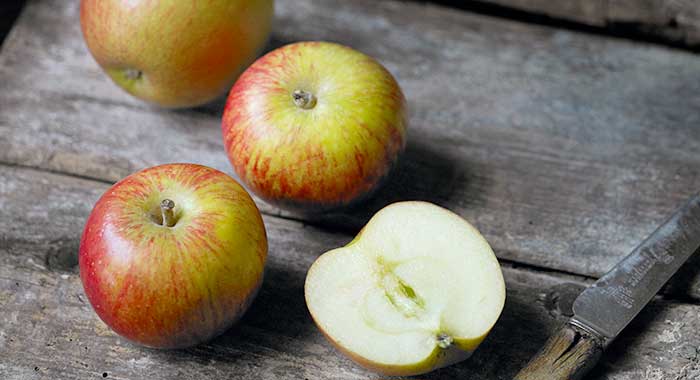
Pronounce it: ap-pel
Grown in temperate regions, apples are one of the most widely cultivated tree fruits. There are over 7,000 varieties in existence, many of which are grown in Britain but, despite that, only around 12 varieties are commonly sold in UK supermarkets, of which many are imported.
Colours range from red, to yellow and green, but all varieties fall into one of two categories: eating, also sometimes called dessert apples (including Cox’s Orange Pippin, Golden Delicious, Granny Smiths, Braeburn, Gala, Pink Lady and Jonagold) or cooking, with the latter being more tart in flavour, a result of their higher levels of malic acid (the best is Bramley, though Blenheim Orange, Grenadier, Reverend W Wilkes and Ida Red are also available). The texture can be very crisp and juicy or more yielding, according to variety.
All apples are a good source of vitamins A and C, as well as fibre.
Read our guide on the health benefits of apples.
Availability
All year round, though British apples are at their best from September through to November.
Choose the best
Look for firm fruit, with no blemishes, bruising or wrinkles. Don’t be fooled by a very shiny skin – many apples are waxed to make them look good. And don’t discard an apple with dry brown patches (‘scald’) – it’s just the result of overexposure to sunlight and won’t affect the quality.
Prepare it
Eating apples can be eaten with the skin on – just wash thoroughly first. Cooking apples should have the skin removed with a paring knife or a peeler (which will take away less flesh); core by cutting them into quarters then cutting the core away or, if you want to keep them whole, by using a corer.
To prevent the flesh turning brown, brush with some lemon juice or keep in bowl of water to which some lemon juice has been added.
Store it
In a perforated bag in the fridge. For longer term storage, wrap each one in newspaper and arrange in a single layer, folded side down, in a wooden box or wicker basket, kept somewhere cool and dark. Check each one regularly to make sure they haven’t gone rotten – one rotten apple will spoil the whole lot.
Cook it
Eating apples can be eaten raw and also go well with cheese or used to make a Waldorf salad.
Cooking apples are good stuffed with a filling such as dried fruits or mincemeat, dusted with sugar, dotted with butter and baked in the oven; chopped for an apple pie or crumble; thinly sliced for a classic French tarte tatin; thickly sliced and pan-fried in butter and sugar and served with ice cream; stewed to make an apple sauce for game or rich meat like pork; grated and added to muesli.
Alternatives
Try pear.
Be the first to comment on "Apple"